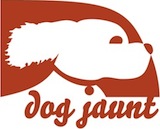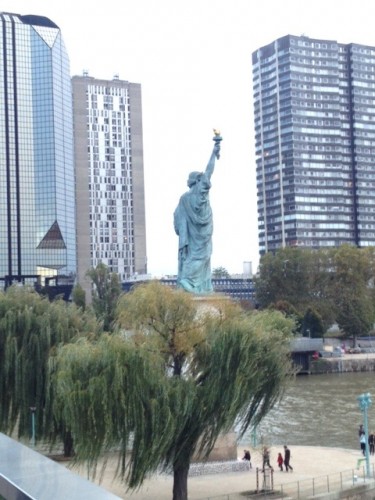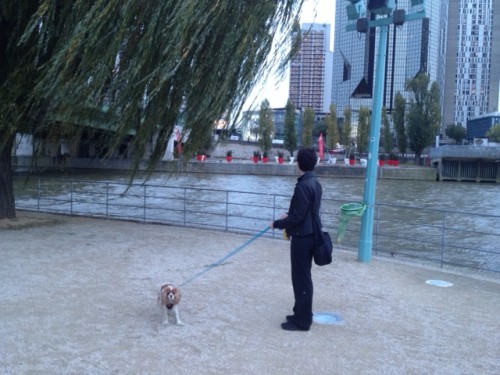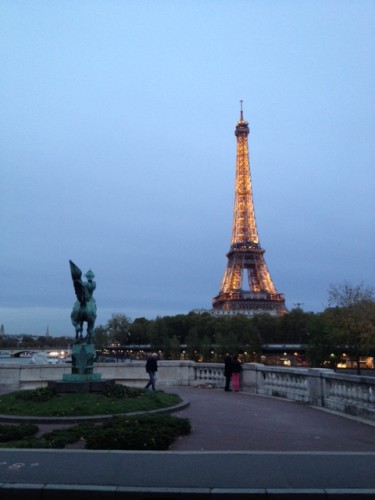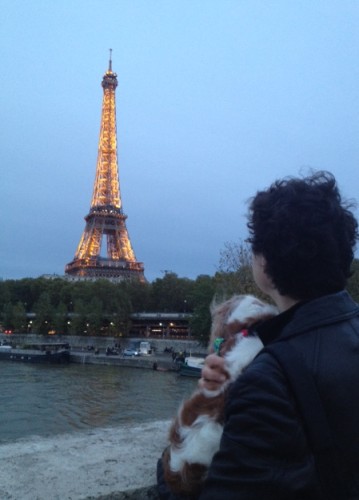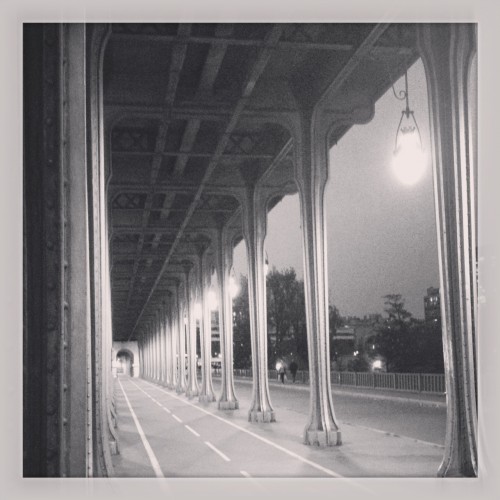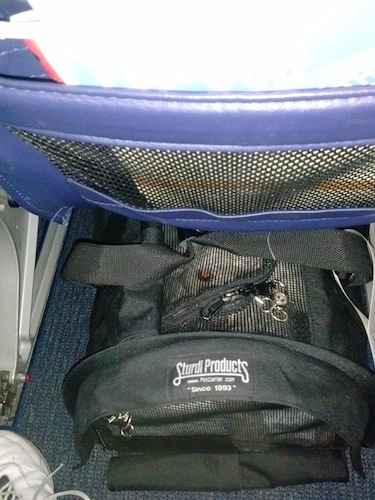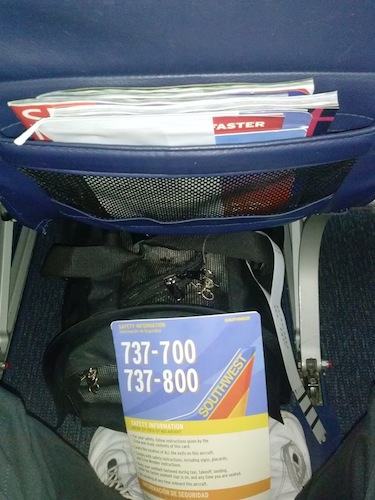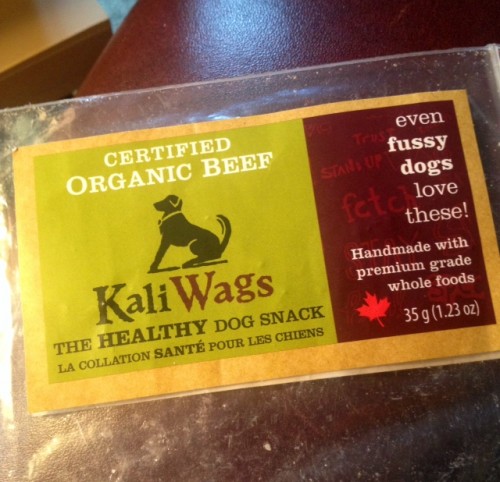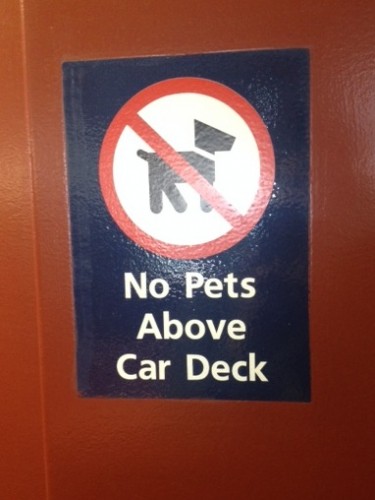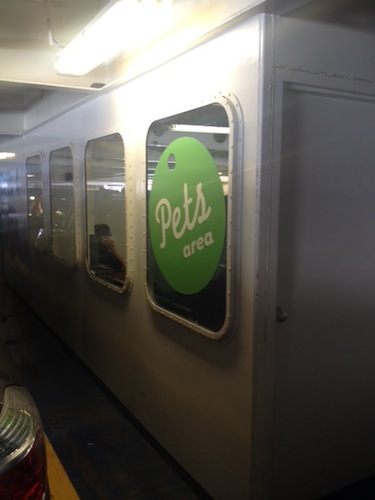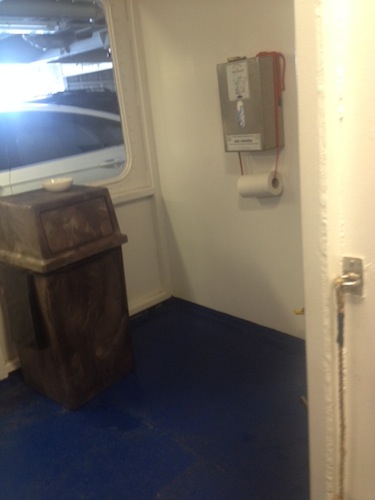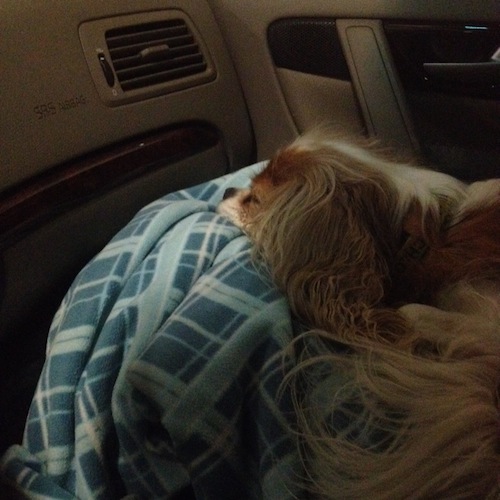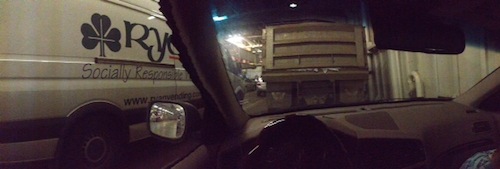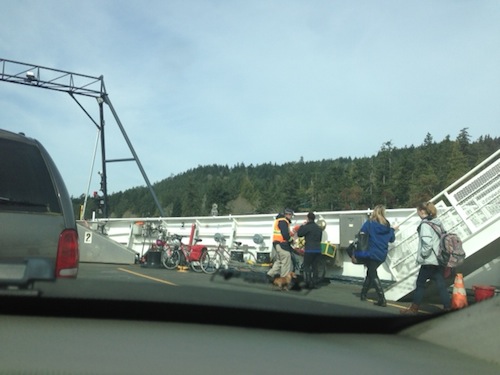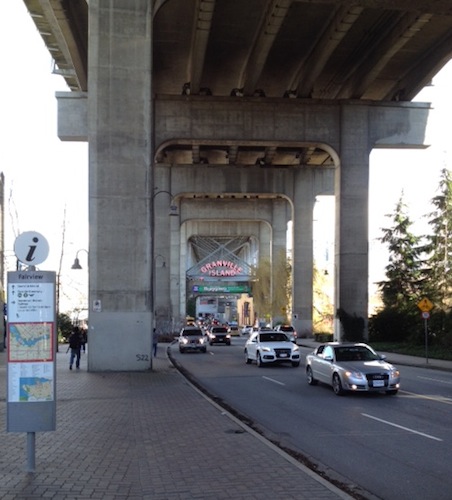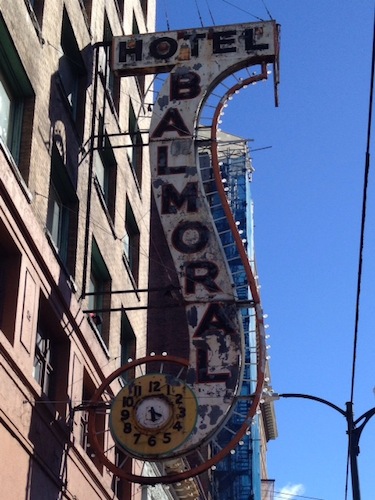Backpack carrier for a larger small dog: PetEgo’s Pet At Work Travel System
I owe this post to reader Catie, who told me that PetEgo now offers its P@W backpack carrier in a large size — I’d admired it before, but the product back then (the current small size) was too small for Chloe. Long story short: The large Pet At Work carrier is a fine size for a larger small dog like Chloe, and with a couple of tweaks, it’s a wonderful addition to our carrier collection. Please note that I paid full price for our P@W Travel System. I will always let you know when I’m reviewing a product or a service that has been paid for (or provided at a discount by) someone else.
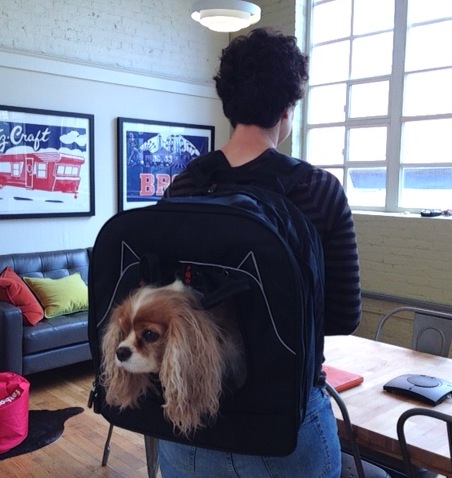
Chloe, ever patient, tries out the Pet At Work carrier
The concept behind the Pet At Work Travel System is appealing: You carry your pet to work (say, for example, on public transit) in the backpack part of the carrier, and when you arrive at your workplace you pull a large Pet Dome out of its slot in the carrier (which also has a padded sleeve for a small laptop) and let your pup recline in that. That scenario doesn’t happen in my life (I work at home, and my husband keeps a Pet Dome at his workplace), but I can imagine biking with Chloe on my back to a destination — a coffee shop, or a park — where it would be good to have a Pet Dome for her to lounge in. It’s more likely, however, that I would leave the Pet Dome at home and use its pocket to carry the gear I normally carry in my purse. It’s a rare pleasure to run into a pet carrier that includes space for human gear too:
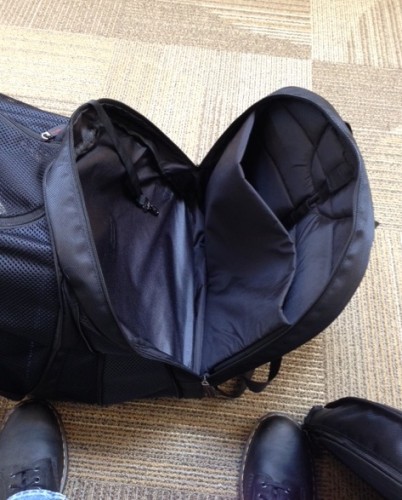
I’ve pulled the Pet Dome out of its slot (you can see it resting against my right foot) to show you the space it leaves available. That sleeve on the right will hold a 15″ laptop, and the main part of the compartment would hold all of my gear (and I’m a gal who carries a big purse). The tether actually belongs in the pet compartment to the left, but I’ve pulled it out of Chloe’s way and flopped it in here instead. I wish PetEgo allowed you the option of detaching the tether.
The downside of doing that is that you lose structural support: The collapsed PetDome provides a lightweight but sturdy foundation that the rest of the backpack hangs from. Carrying a laptop helps, but even with just a heap of stuff from my purse (the last picture, below) in that pocket, Chloe didn’t list too much.
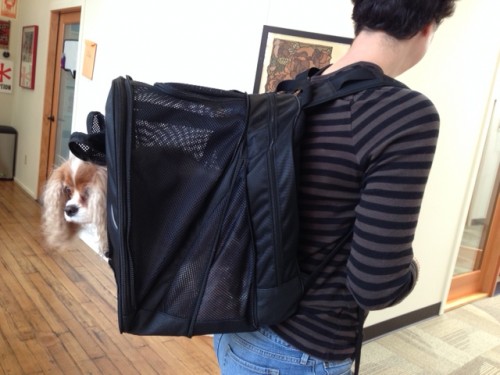
The P@W carrier with the Pet Dome in its slot. Plenty of room for Chloe, and her “floor” is pretty level.
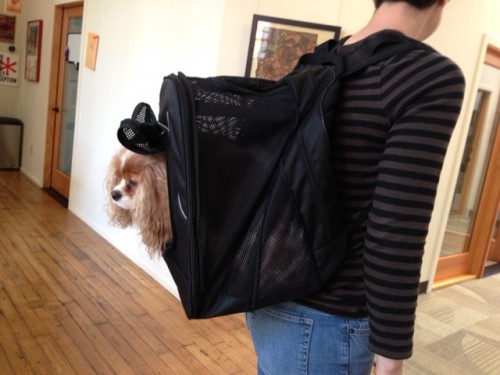
Pet Dome removed, and replaced with my small MacBook Air laptop. A bit more sag in Chloe’s “floor.”
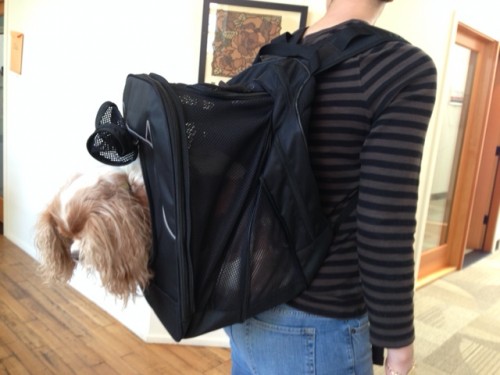
No Pet Dome or laptop, just random purse stuff. This is the worst-case scenario, in terms of structural support; while Chloe’s “floor” is angled, she didn’t seem unduly concerned about it. If I thought I’d never carry a laptop or a Pet Dome, I might consider getting a piece of thick foam cut into the same shape as the collapsed Pet Dome, and slip that into the laptop sleeve.
As longtime Dog Jaunt readers already know, Chloe is a large small dog (she weighs about 13 lbs., stands about 12″ tall at her shoulder, and measures about 16″ from nape of neck to base of tail), and I have to shop carefully for carriers that fit her. Add the large Pet At Work backpack to the list — when all of its gussets are unzipped, it offers a space that is 16.5″ wide, 11.5″ deep, and about 16″ tall (the width and height have a fair amount of give, since the “walls” and “ceiling” of the space are nylon mesh). That’s plenty of room for her to sit up, shift around, and view the world. It’s also just enough room for her to lie down in a tight circle, but if I anticipated that she’d be doing a lot of resting, I’d pack the Pet Dome.
The following picture shows the pet compartment at its largest, with both of its gusset zippers unzipped. In this configuration (the only one that works for Chloe, or other dogs her size), the carrier has two entrances, one on top, and one on the back. As you can see, the back entrance’s “door” can be rolled up and secured (with Velcro); in that event, you’d likely want to use the provided tether to discourage your pup from leaping out.
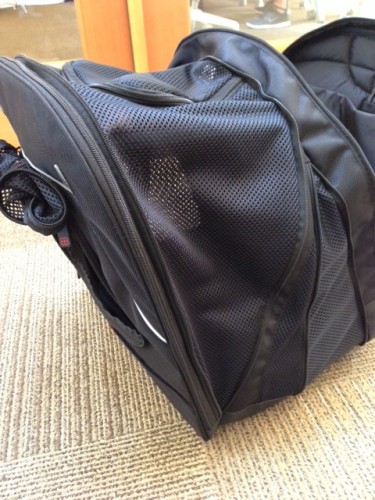
Roomiest pet compartment option (both gussets unzipped). Two rods in nylon sleeves, sewn to the “ceiling” of the pet compartment, keep the top propped outwards: Swing them up and use the Velcro tabs on their ends to attach them to the upper corners of the compartment.
If you have a small pet, you might prefer this following configuration, with only one of the gusset zippers unzipped. The top entrance is no longer available, but the side and back panels still provide a lot of cross-ventilation.
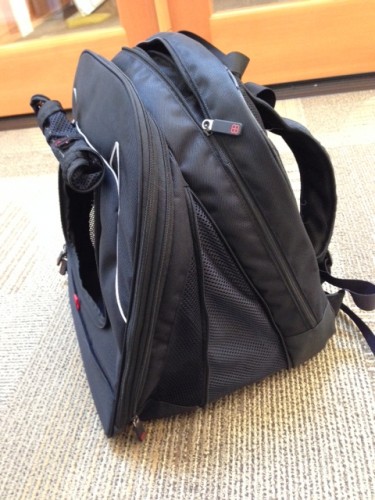
It’s worth noting that with one fewer gusset unfurled, using the Pet Dome compartment as a purse (that is, removing the Pet Dome) won’t make the pet compartment floor tilt as much.
These are the only two pet-carrying configurations available; once you close the second gusset zipper, you’re left with a compartment that could hold a sweater or, given that a couple of mesh panels are still exposed, gym clothing.
In both of the pet-carrying configurations, the “floor” panel (a piece of what feels like thick plastic, encased in nylon), can be pulled away from the Velcro tab securing it to the wall of the pet compartment and laid flat, where it’s held in place by gravity and friction. Softness is provided by a small pad, nylon on one side and fleece on the other, which you lay on top of the floorboard. It’s not secured to anything, and scoots around under your dog, especially while you’re hoisting the carrier onto your shoulders.
Chloe really dislikes that scooting, and I plan to fix it with more Velcro. The same “male” Velcro tab that holds the floor panel to the wall of the pet compartment will make itself useful again: I’ll sew a strip of “female” Velcro (the softer, loop side) to the pad, and that’ll provide one point of stability (since it’s the softer part of a Velcro pairing, and therefore won’t catch on your dog’s fur, you could sew strips to both the nylon and the fleece sides of the pad, if you care about reversing the pad in hot/cold weather). I’ll sew an additional female Velcro strip on each short end of the pad. There may not be enough slack in the nylon covering of the floorboard to allow the matching male strips to be sewn on; if not, I’ll use stick-on Velcro strips for the floorboard. The result will be three points of stability for the pad, which will greatly improve Chloe’s outlook on life.
Aside from her objections to the shiftiness of the provided floor pad, Chloe clearly approves of the carrier — even after the jostling that occurs while I wriggle out of the straps and swing her down to a chair or the floor, she’s in no hurry to hop out.
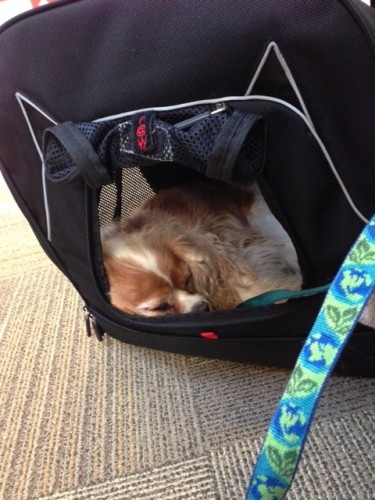
Snoozing happily.
I like it too — the thought that went into its features pleases me, and it’s well-made. The shoulder straps are comfortable, and I like how the same padding that protects your laptop also cushions your back. A simple strap at the top lets you pick the carrier up vertically (picking it up by the tops of the shoulder straps would tilt the bag, potentially disconcerting your pet). A long, low pocket just below the back “entrance” is big enough to hold small items like a roll of poop bags and treats.
One last thought: It occurred to me that the Pet At Work backpack might work as an in-cabin carrier. You’d have to take the Pet Dome out as you arrived at your seat, and gently rotate the carrier onto the strap side, so your dog ends up resting on the padding that usually protects your back. The two props that support the pet compartment will now be holding one end of your pet’s “roof” up. Deploy some more Velcro to secure the panel that’s normally the floorboard in place — you need it to support the other end of your pet’s roof, and it no longer has gravity on its side in this orientation. The overall height of the rotated carrier, minus the Pet Dome, is about 11″, with plenty of give (but be gentle with those two support rods), and the length and width are both about 16″. For a dog Chloe’s size, I’d do it only if I was traveling with someone else, and could poach some of their legroom for the Pet Dome — as soon as we leveled off, I’d unfold the Pet Dome and nudge her into it from the carrier (how convenient that the carrier’s usual top entrance acts as a side entrance when the carrier is under a plane seat!).
How does the Pet At Work carrier compare with the Canine Casual, another soft backpack carrier that works for larger small pets? As far as the space available for your pet goes, they’re close — as you can see in this picture, the pet compartments are about the same height and depth; however, what you can’t see from this angle is that the Pet At Work space is about 1-2″ wider than the Canine Casual space. The Pet At Work carrier is therefore a bit roomier than the Canine Casual.
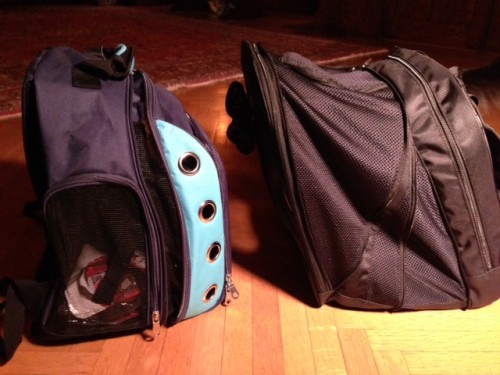
The pet compartment for the Canine Casual (on the left) includes the area behind the powder-blue, grommeted panel; the pet compartment for the Pet At Work (on the right) ends where the mesh ends (the solid area to the right is the Pet Dome compartment). It’s worth noting, though, that if the Pet Dome is removed, part of that space becomes available to your pet, since the inner wall of the Pet Dome compartment is thin nylon. In the picture of Chloe snoozing, her bottom was pressing into the empty Pet Dome compartment.
The Pet At Work carrier has more mesh ventilation panels, but I don’t mean to criticize the Canine Casual by saying that — I still think the Canine Casual carrier’s mesh panels and giant grommets provide good ventilation. Both are dark, which is fine for cool weather, but not ideal for warm weather (one Dog Jaunt reader reports that she found the large Pet At Work carrier in a tan color, so I’ll keep checking the PetEgo listing to see if it becomes available again).
The Pet At Work carrier minus the Pet Dome weighs about the same as the Canine Casual (2.96 lbs. versus the Canine Casual’s 2.86 lbs.), but with the Pet Dome on board, the Pet At Work System weighs nearly 6 lbs. The Pet At Work System is significantly more expensive ($150, on Amazon, versus about $80 for the Canine Casual).
The two carriers perceive the same need (a backpack carrier for a larger small dog, who may also want to spend time lying down) but address it in a different way: The Canine Casual carrier expands, with the help of a gusset, into a mesh tent, while the Pet At Work carrier stows a mesh tent (the Pet Dome) in a separate slot. Which one you choose will depend on how large your larger small dog is, and which price tag your budget can handle.
Amazon link: Pet at Work Travel System (large) from PetEgo
